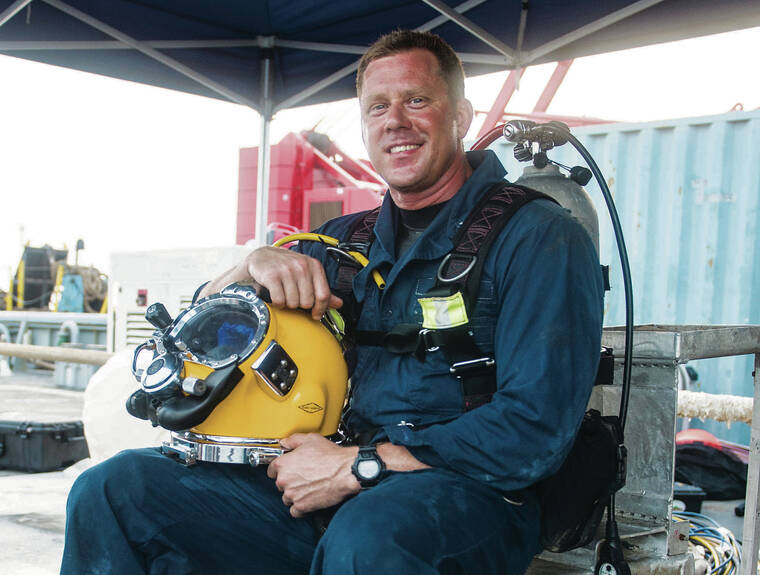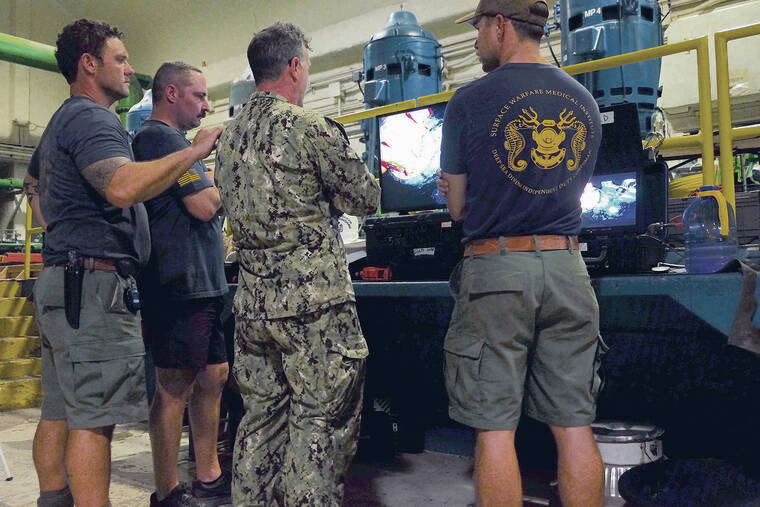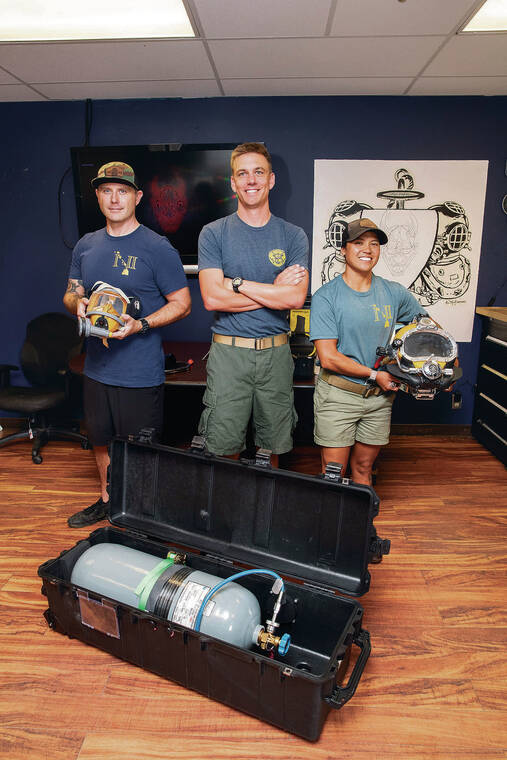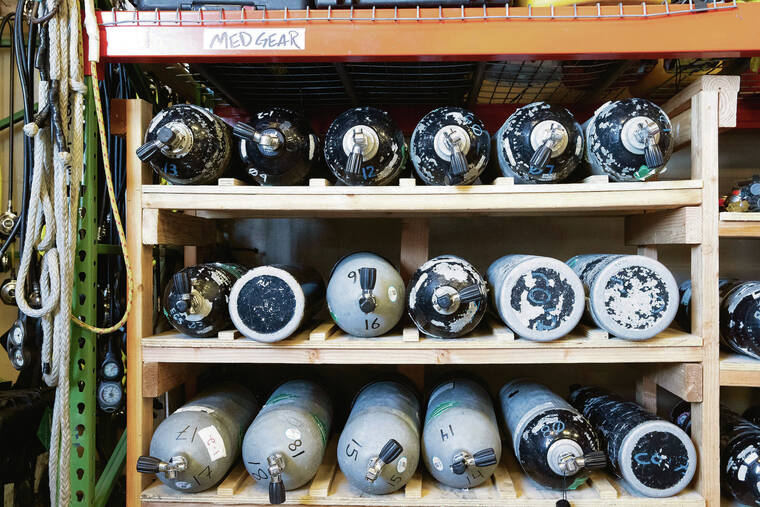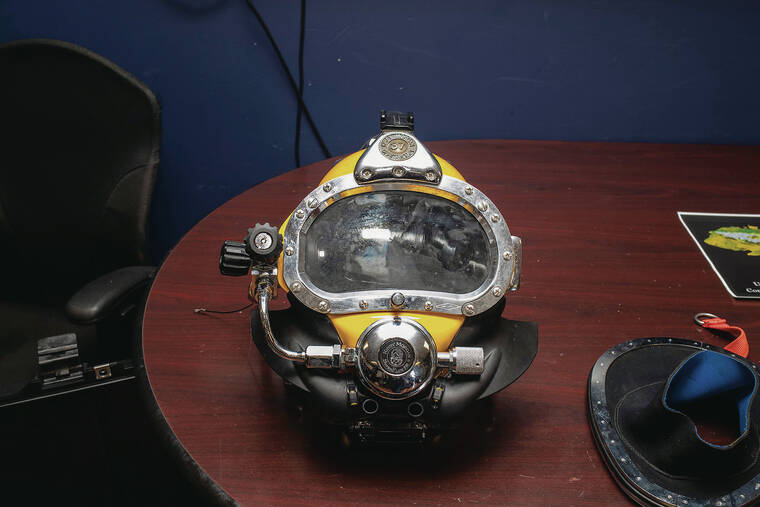For three months members of the Pearl Harbor-based Mobile Diving and Salvage Unit One worked inside the Navy’s contaminated Red Hill water well, becoming unlikely front-line responders to the crisis.
The mission was personal.
While they navigated a taxing assignment using bulky equipment in hazardous conditions, some of the members of MDSU1 also had family who had gotten sick at home from the fuel spill and still struggle with symptoms.
Current and former members of the unit spoke to the Honolulu Star-Advertiser about the mission that brought them into the heart of the Red Hill water crisis.
MDSU1 is unique. It’s tasked with salvaging damaged and sunken vessels, but has taken on missions as varied as harbor clearance and planting coral in Nanakuli. Red Hill was unlike any other.
“I go into the ocean, open bodies of water, maybe working on some ships or crawling in and out of things, but certainly not in a mountain,” said Navy Diver 1st Class Andrew Gose. “That was a brand new experience for me.”
Gose lives in the Pearl City Peninsula housing with his wife and daughter. His home was among those affected when fuel from the Navy’s underground Red Hill fuel facility contaminated the service’s Oahu water system on Nov. 20.
Naval Facilities Engineering Systems Command, better known as NAVFAC, oversees Red Hill and called up the divers to go into the well to conduct a survey. The mission quickly expanded.
The divers juggled the mission while wondering how the spill was affecting their own lives. Now- retired Senior Chief Master Diver Brian Simic, 40, said that his family became seriously ill from fuel exposure.
Simic served 20 years in the Navy, including 17 stationed in Hawaii as a diver. The job took him around the world until his last major mission at Red Hill.
Normally, work was work and home was home for Simic. Red Hill was different.
“I had never experienced something like this before where my family, especially my wife, was so ill, and then I was tasked to go respond to the cleanup efforts of the thing that makes my wife sick and made my family sick — and then made me sick, for that matter,” Simic said. “You see exactly where your water is coming from. You know that the faucet you turn on at your home is from that water that I’m cleaning up … it just makes that situation that you’re living very real.”
Now retired and having returned to Florida, Simic said both he and his family members continue to exhibit symptoms that he believes are tied to exposure to the fuel. He said he’s worried other responders might also have been affected.
A Dangerous Survey
According to the Pacific Fleet’s investigation released in June, the initial responder to the spill on Nov. 20 was taken to a hospital that evening for chemical burns, and a second person also was injured. Long after the spill, the hallway where the spill occurred still smelled of petroleum.
The well itself sits down a long tunnel that leads to a water pump room. The smell of petroleum fumes gets stronger near the well. Poor ventilation had been raised in previous reports as a potential safety hazard. For the responders, the poor ventilation became part of the job.
“Fortunately enough, I couldn’t smell the fumes or anything,” Gose said in a matter-of-fact tone. “I lost my sense of smell to COVID almost two years ago now. So I guess I got lucky there.”
In the pump room, potential challenges tied to the cleanup mission are apparent. There, the well is accessible through a maintenance hole that opens to a narrow, slippery 80-foot ladder. Below is a catwalk that sits about 12 feet above the water itself.
“It automatically kind of gets the gears turning … of like, ‘All right. How can we (get out) in the event of a casualty?’” said Chief Navy Diver Melissa Nguyen, a diver with 15 years experience.
Operating in the water required divers to wear protective helmets and sealed dry suits. The initial entry of the first diver didn’t go according to plan.
Suiting up takes time, and the diver was wearing the heavy dry suit in the cramped and humid pump room. Due to the bulk of the diver’s gear, descent was slow-moving, “so he was overheating at the water’s edge,” said MDSU1 salvage officer Lt. Cmdr. Chris Wilkins.
The diver was brought back to ground level without sustaining serious health effects. But it was an early sign of how challenging — and dangerous — the mission would be.
Eventually, MDSU1 managed to get divers into the water, which helped cool them. Then they were tasked with going into the approximately 1,100 foot-long tunnel to look for sources of contamination.
Trying to identify sources of contamination, the divers mostly swam on the water’s surface — with little room between the surface and the top of the roughly 10-foot high tunnel. Relying on air hoses connected to a tank in the pump room, the divers managed to make it about 300 feet into the pitch-black tunnel.
“What they were looking for was any dripping or sources of liquid coming into the water,” Wilkins said. “They are in this helmet and they’re in their full rig, so … they couldn’t tell what was coming out of the rocks. They could just find dripping. And they took bottles back there to collect samples that were taken off by NAVFAC to be analyzed to see if they can pinpoint where contamination was coming from.”
The severity of the contamination was evident.
“They were starting to get the fumes even inside of the helmet,” Wilkins said. “So there were still risks of having them move through there with all the protective equipment. There’s still seepage of fumes because it was pretty big in the air down there. The risks involved were too high to do repeated trips in there. They found what they needed to find as best they could.”
MDSU1 told NAVFAC officials they had access to pumps and other equipment, designed for decontamination and removal of water and other liquids during ship salvage operations, that Naval Sea Systems Command was storing at Pearl Harbor.
“These are the emergency response items for salvage work,” Wilkins said. “We actually have one of the warehouses located immediately adjacent to us here on the compound. They maintain all of the pump systems that we operate.”
But getting into the well with the pumps created another complication. The pumps were designed to be moved on and off of ships — not deep into volcanic rock. So teams had to get creative to get them through the long tunnel and into the already crowded pump room where divers, engineers and technicians were working.
Simic said, “Going up to the Red Hill site, it was packed. There were construction vehicles everywhere. There was people working outside, people working inside.”
“After we established the pumps, we did continue working in the well for several months, but it wasn’t doing our normal diving stuff,” Wilkins said. “It was any task that had to be done inside the well. They (monitoring crews) didn’t have the ability to put ventilation in the space, which would be required to have their guys working. So really, we just became the worker bees in this space.”
The divers worked in pairs on the dimly lit catwalk, situated in a lava rock cavern. “Once you start moving down the ladder here, it’s just bare rock and you see the water weeping out of the rock as you go down,” Wilkins said. “By the time you’re at the waterline, so much is weeping out from 80 feet above you it sounds like it’s raining down there, and it’s just constant fall of water.”
Gose said working inside the well made him think of the caverns from the 1980s adventure film “Goonies.”
Nguyen said the site evoked “definitely … an eerie feeling in a way because there’s not many people who have entered. You could feel the mana of the well, like the energy and all that.”
Simic said the water below the catwalk was visibly contaminated.
“There was a foam-like substance on top of the water and that spread pretty much all over the area that your eyeball could see,” he said.
‘Walking the Razor’s Edge’
The falling water from the lava rock helped keep divers, who wore long-sleeved work uniforms, relatively cool. And the air funneled to divers through a hose-tank apparatus was cleaner than the air that the rest of the supporting crew was breathing in the pump room. Still, Simic said, the risk of diver dehydration remained high, and their masks constantly fogged up.
Gose said the biggest challenge was working in the pump room, watching monitors and gauging the safety of the mission — regularly sending messages to the men and women below to ensure they were safe. He said he also had to monitor safety conditions for personnel working in support functions in the pump room.
While working at Red Hill, Simic began to notice his eyes drying and that he was becoming short of breath.
“Every human body is not the same,” Simic said. The underground cleanup site “affects everybody differently. You’re kind of walking that razor’s edge of knowing when to pull your guys back for their own safety, especially with divers. Divers are very motivated. We have a very can-do attitude and we’re gonna put ourselves in harm’s way to get the job done.”
When the mission began, the MDSU1 teams worked 12-hour shifts, which took a toll.
“When we realized we had to sustain that, we broke it up into, like, two sixes, so we’d have a team come in the morning and then a team come in to relieve that team,” Nguyen said.
Nguyen said that they worked together to manage workloads as many members of MDSU1 had holiday plans before the well pipe burst shortly before Thanksgiving.
Despite a bold pronouncement by NAVFAC Pacific chief Rear Adm. Dean VanderLey to the state Legislature on Dec. 10 that he intended to have the crisis resolved and families returning home by Christmas, the response dragged on well beyond the holiday season.
“That was a very big drive for me to want to volunteer my time,” Gose said. “We had a lot of people on leave. The guys that showed up every day, day in and day out, were giving of themselves to work those hours.”
Simic’s wife, Jamie, was hospitalized at Tripler Army Medical Center around the time MDSU1 began its Red Hill mission. During her time in the hospital, she said doctors refused to test her for petroleum exposure and instead tried to test her for other ailments. Meanwhile, their children also needed care.
“The focus was family and (MDSU1) knew that,” Simic said.
While he’s critical of the Navy’s top brass, Simic said his leaders at MDSU1 and fellow divers supported his family. “The command gave me the time to take care of my family and then … put me back to work,” Simic said.
‘We Were There To Make It Better’
Eventually the Navy installed massive granular activated carbon filtration systems — or GACs — at Red Hill to remove the water, beginning full-scale operations on Feb. 1. It has been discharging the filtered water into nearby Halawa Stream. Divers continued working in the well, mostly installing and monitoring absorbent materials to try to get more petroleum out of the water.
“We went all the way through, I believe, Feb. 22,” Wilkins said. “At that point, we packed up all of our equipment and moved out of the well, and we haven’t been back since.”
Almost six months later, the threat tied to Red Hill water contamination still looms large as the Navy wrestles with the fallout that has strained its credibility with both the local community and with military families.
Simic said he has continued to suffer dry eyes, headaches and fatigue, which he links to contaminant exposure at Red Hill. He officially left the military in March, and worries about his fellow sailors who also were exposed.
“Especially if you’re youthful military, your young guys, you’re not gonna feel it right away,” Simic said. “Just because you don’t feel it doesn’t mean you’re not going to have something happen down the road.”
Simic encouraged military personnel and civilians involved in the cleanup effort, along with consumers of the Navy’s drinking water, to document any symptoms.
“It’s got to be a concern for the military to track anybody who’s been tasked with working so close to such a contaminated atmosphere,” Simic said. Moving forward, he added, there should be “some type of registry to make sure that guys are going to be monitored and followed,” and that reported symptoms are investigated and included in their medical records.
Simic said so far, it has been a challenge for him and family members to get treatment. While the military documented his dry eyes before he retired, his medical records don’t link it to petroleum exposure. None of his wife’s or children’s illnesses have been officially tied to fuel exposure, either.
Now that they live in Florida, Simic said it’s been frustrating explaining to medical providers what happened at Red Hill. Media coverage has been limited on the mainland, and Simic said providers who have little knowledge about the contamination and cleanup effort appear to be skeptical.
Today MDSU1 remains busy.
The unit participated in the humanitarian disaster response portion of exercise Rim of the Pacific and has future missions lined up around the region.
While Red Hill continues to be a political flashpoint in Hawaii, members of MDSU1 are proud of their response efforts. Gose said, “I just want folks to know that we were there to make it better — do whatever we could with the tools we had available.”
